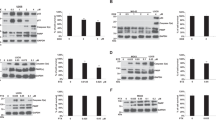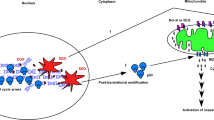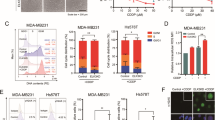Abstract
Mechanisms by which chemotherapeutic agents induce apoptosis are not completely understood. Current knowledge of the actual pharmacologic effects of chemotherapy and their biochemical mechanisms are better understood than the downstream events, which initiate the apoptotic cascade. The chemotherapeutic agent cisplatin causes DNA damage and can induce apoptosis in several types of human cancers. We found the formation of previously unreported nuclear complexes between the tumor suppressor protein p53 and the pro-apoptotic protein Bax, in human melanoma cell lines induced into apoptosis following cisplatin exposure. These detergent resistant complexes were detected: after wild type (wt) p53 and Bax increased in the nucleus; at the same time when active cytoplasmic apoptosis related protease, caspase 3/CPP32 appeared; and prior to the detection of apoptotic DNA fragmentation. Three channel fluorescence laser scanning confocal image microscopy revealed that the nuclear Bax/p53 complexes remained in the nucleus and localized proximal to DNA fragmentation sites as assayed by TUNEL after cisplatin exposure. Two human melanoma cell lines, expressing wt p53, were induced into apoptosis after cisplatin exposure, however they differed in the timing of this induction. In both cell lines the formation of nuclear Bax/p53 co-immunoprecipitable complexes correlated with the timing of the induction of apoptosis. The degree of apoptosis induced by different concentrations of cisplatin correlated with the amount of nuclear Bax/p53 complexes. The co-immunoprecipitation of Bax and p53 was found regardless of the antibodies tested and was specific since Bcl-xL/p53 complexes were not detected. Additionally, the human prostate cancer cell line, LNCaP, also formed nuclear Bax/p53 complexes only after apoptosis was induced by paclitaxel.
This is a preview of subscription content, access via your institution
Access options
Subscribe to this journal
Receive 50 print issues and online access
$259.00 per year
only $5.18 per issue
Buy this article
- Purchase on Springer Link
- Instant access to full article PDF
Prices may be subject to local taxes which are calculated during checkout







Similar content being viewed by others
References
Albino AP, Vidal MJ, McNutt NS, Shea CR, Prieto VG, Nanus DM, Palmer JM and Hayward NK. . 1994 Mel. Res. 4: 35–45.
Barinaga M. . 1998 Res. News Sci. 280: 32–34.
Bedner E, Li X, Gorczyca W, Melamed MR and Darzynkiewicz Z. . 1999 Cytometry 35: 181–195.
Caelles C, Helmberg A and Karin M. . 1994 Nature 370: 220–223.
Dennis LK. . 1999 Arch. Dermatol. 135: 275–280.
Dignam JD, Lebovitz RM and Roeder RG. . 1983 Nuc. Acids Res. 11: 1475–1489.
Gavrieli Y, Sherman Y and Ben-Sasson SA. . 1992 J. Cell. Biol. 119: 493–501.
Gross A, Jockel J, Wei MC and Korsmeyer SJ. . 1998 EMBO J. 17: 3878–3885.
Hall HI, Miller DR, Rogers JD and Bewerse B. . 1999 J. Am. Acad. Dermatol. 40: 35–42.
Haupt Y, Rowan S, Shaulian E, Vousden KH and Oren M. . 1995 Genes Dev. 9: 2170–2183.
Ho YS, Lee HM, Chang CR and Lin JK. . 1999 Biochem. Pharmacol. 57: 143–154.
Janus F, Albrechtsen N, Knippschild U, Wiesmuller L, Grosse F and Deppert W. . 1999 Mol. Cell. Biol. 19: 2155–2168.
Knippschild U, Oren M and Deppert W. . 1996 Oncogene 12: 1755–1765.
Kobayashi T, Ruan S, Clodi K, Kliche KO, Shiku H, Andreeff M and Zhang W. . 1998 Oncogene 16: 1587–1591.
Li G, Tang L, Zhou X, Tron V and Ho V. . 1998 Mel. Res. 8: 17–23.
Mandel M, Adam L, Mendelsohn J and Kumar R. . 1998 Oncogene 17: 999–1007.
Marchenko ND, Zalka A and Moll UM. . 2000 J. Biol. Chem. 275: 16202–16212.
Martin DS, Stolfi RL and Colofiore JR. . 1997 Cancer Invest. 15: 372–381.
Martin SJ, Reutelingsperger CP, McGahon AJ, Rader JA, van Schie RC, LaFace DM and Greene DR. . 1995 J. Exp. Med. 182: 1545–1556.
Miyashita T and Reed JC. . 1995 Cell 80: 293–299.
Moll UM, Riou G and Levine AJ. . 1992 Proc. Natl. Acad. Sci. USA 89: 7262–7266.
Muchmore SW, Sattler M, Liang H, Meadows RP, Harlan JE, Yoon HS, Nettesheim D, Chang BS, Thompson CB, Wong SL, Ng SL and Fesik SW. . 1996 Nature 381: 335–341.
Mummenbrauer T, Janus F, Müller B, Wiesmüller L, Deppert W and Grosse F. . 1996 Cell 85: 1089–1099.
Nicholson DW, Ali A, Thornberry NA, Vallancourt JP, Ding CK, Gallant M, Gareau Y, Griffin PR, Labelle M, Lazebnik YA, Munday NA, Raju SM, Smulsom ME, Yamin T-T, Yu VL and Miller DK. . 1995 Nature 376: 37–43.
Oltvai Z, Milliman CL and Korsmeyer SJ. . 1993 Cell 74: 609–619.
Ouyang H, Furukawa T, Abe T, Kato Y and Horii A. . 1998 Clin. Cancer Res. 4: 1071–1074.
Pan G, O'Rourke K and Dixit VM. . 1998 J. Biol. Chem. 273: 5841–5845.
Polyak K, Xia Y, Zweier JL, Kinzler KW and Vogelstein BA. . 1997 Nature 389: 300–305.
Sakao Y, Noro M, Sekine S, Nozue M, Hirohashi S, Itoh T and Noguchi M. . 1998 Japan. J. Cancer Res. 89: 1020–1027.
Schendel SL, Xie Z, Montal MO, Matsuyama S, Montal M and Reed JC. . 1997 Proc. Natl. Acad. Sci. USA 94: 5113–5118.
Schlamp CL, Poulsen GL, Nork TM and Nickells RW. . 1997 J. Natl. Cancer Inst. 89: 1530–1536.
Tremblais K, Oliver L, Juin P, Le Cabellec TM, Meflah K and Vallette FM. . 1999 Biochem. Biophys. Res. Commun. 260: 582–591.
Wolter KG, Hsu YT, Smith CL, Nechushtan A, Xi XG and Youle RJ. . 1997 J. Cell Biol. 139: 1281–1292.
Yin C, Knudson CM, Korsmeyer SJ and Van Dyke T. . 1997 Nature 385: 637–640.
Zerp SF, van Elsas A, Peltenburg LT and Schrier PI. . 1999 Br. J. Cancer 79: 921–926.
Zhivotovsky B, Samali A, Gahm A and Orrenius S. . 1999 Cell Death Differ. 6: 644–651.
Acknowledgements
Support for this work came from the Columbia Skin Disease Research Center grant NIH-NIAMS #P30AR 44535; the Dan Belsky Cancer Research Fund; Columbia Comprehensive Cancer Center Core Grant NCI-P30-CA13696-27 (RL Fine) and the 1999 AACR-Intergen Young Investigator Award (AJ Raffo). The authors would like to thank Drs Paul Brandt-Rauf, Ralph Buttyan and David Cobrinik for helpful discussions about the manuscript. The Confocal Microscope facility is part of the Herbert Irving Cancer Center of Columbia University under the direction of Dr Lisa Pon and supported in part by NIH grants #1S10 RR10506 and 5 P30 CA13696. The authors wish to thank Theresa Swayne, Facility Manager and Dr Pon for their help in obtaining the confocal images.
Author information
Authors and Affiliations
Rights and permissions
About this article
Cite this article
Raffo, A., Kim, A. & Fine, R. Formation of nuclear Bax/p53 complexes is associated with chemotherapy induced apoptosis. Oncogene 19, 6216–6228 (2000). https://doi.org/10.1038/sj.onc.1203995
Received:
Revised:
Accepted:
Published:
Issue Date:
DOI: https://doi.org/10.1038/sj.onc.1203995
Keywords
This article is cited by
-
Elephant TP53-RETROGENE 9 induces transcription-independent apoptosis at the mitochondria
Cell Death Discovery (2023)
-
Distinct functional domains of PNMA5 mediate protein–protein interaction, nuclear localization, and apoptosis signaling in human cancer cells
Journal of Cancer Research and Clinical Oncology (2016)
-
Oncogenes associated with drug resistance in ovarian cancer
Journal of Cancer Research and Clinical Oncology (2015)
-
Role of BAX for outcome prediction in gastrointestinal malignancies
Medical Oncology (2013)
-
Mortalin–p53 interaction in cancer cells is stress dependent and constitutes a selective target for cancer therapy
Cell Death & Differentiation (2011)



